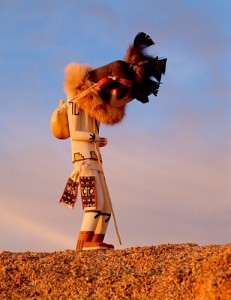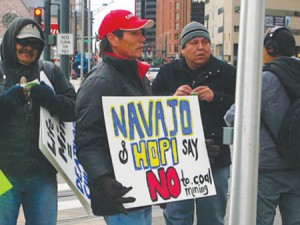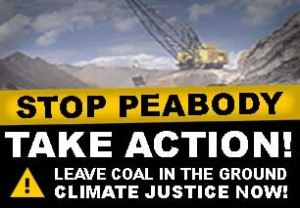“Underneath your feet lies enormous wealth. Guard it.
Do not fall sleep, for if you do, it will be pulled out.
Do not use it until the right time to do it, in the right way,
and only use it for the right purposes”.
~Instructions from Hopi Ancestors.
In 1970, a chain of dynamites exploded, and ripped Black Mesa apart. Then deep
water wells were sunk into the earth. The traditional elders from Hotevilla and
Shungopavy, and their allies from other villages, stood helplessly as the world’s largest
strip-mining began. Their worst fears became a reality. The Hopi people fell asleep. The
covenant with Massau was broken. They feared the Fourth World of the Hopi was coming
to an end. Massau, the Guardian of Mother Earth knew about the wealth and why it was put
there, within the cupped-shaped human hand, Hopi call Tuwanasavi, Earth Center, now
called Black Mesa. The Hopi ancestors met Massau at the fingertip of Black Mesa, as they were
journeying, looking for a safe place to start a new civilization. They were fleeing from
Palatki, their ancestral city far away in the South. They followed a river and came out of a
deep canyon, the Hopi call Sipapuni*, the umbilical cord, a sacred shrine marking “a place
of emergence to the Fourth World”.The elders sang an ancient prophecy song with tears in their eyes: “One day you will sell rain waters. For this you will be punished. Springs, once abundant, will dry up and you will begin your exodus. Carrying tin cups and belongings on your backs, you will
visit the springs now dry. For you have broken the covenant”.
From the beginning strip mining was not the right thing, not the right time and not in
the right way. Even the lease which set it all in motion was not right. Negotiated singlehandedly
by John Boyden, a lawyer, hired by the Hopi Tribal Council in the 1950’s to
resurrect the Hopi Tribal Council and to clear the way for corporations interested in
prospecting for coal, oil, and uranium. Records, recently uncovered by law students at the
University of Colorado, show conclusively that Boyden was billing Peabody for expenses
during the time when he was representing the Hopi in negotiations with Peabody Coal Co.
for rights to Hopi coal (Boyden’s conflicted behavior is disclosed in “Fire on the Plateau”
written by Charles Wilkinson, a distinguished professor of law at the University of
Colorado).
***************************************************************
*Sipapuni is located about 100 miles west of Black Mesa deep in a canyon today known as the Grand Canyon, Hopi call Öngtupkya (SaltCanyon). The big river is Colorado River.
Paalatki is the name of the mythical city located somewhere in Central America.
In the Peabody coal lease, approved by former U.S. Secretary of the Interior Stewart Udall,
the Hopi Tribe unwittingly approved payments of $1.67 for use of fossil water stored in an ancient
aquifer, and a coal royalty rate of 3.333% of market value, well below the market value that the
federal government was charging mining companies on public lands. The intent of coal mining on Black Mesa was: first, to provide low-cost electricity to bring water from the Colorado River to Phoenix and Tucson, via Central Arizona Project; second, to supply a huge demand for electricity in booming cities in the Southwest. Black Mesa became a sacrificial area for producing cheap electricity. The Hopi Tribal Council did not understand the magnitude of the mining and the devastation it would cause. Little did they know that by the end of 2005, over 45 billion gallons of pristine groundwater would be used to operate a coal slurry project, enough water to sustain the entire Hopi population of 10,000 for over 300 years.Neither did they know that the hydrologic balance
would be permanently and irreparably damaged. After close to 40 years of strip mining
operations the Hopi people still have no idea of the magnitude of damages done to Black Mesa, their
sacred homeland. The real extent of damages is hidden in the computers — the same computers used by scientists to assure the Hopi and Navajo people that mining will cause no “significant material damage” to their land, plants, waters, wildlife and cultural resources. In fact they claimed to have irrefutable proof that the negative impacts will be minimal. Agents of the federal government who approved the leases committing 670 million tons of coal on 68,000 acres to Peabody justified their decision by saying the economic benefits will far out-weigh the damages. Today less than a dozen Hopis work at the mine; the Hopi Tribe is receiving less than $10 million, and unemployment is among the highest in Indian Country.
The people who walk the land see the impact and tell a different story. Washes
and springs they said, have dried up just as the ancestors had predicted. Different
types of birds and plants are gone and Moencopi Wash, which used to water cornfields,
is dry most of the year. They blame Peabody and the federal government. Those who
walk the land, who tend the fields, and honor the springs are witness to the damage.
They see and know more than those who sit in the cooled rooms where they stare at
computers and crunch numbers. The damage reached deep into Hopi.
Rain People no longer visit as frequently as they use to because by allowing waters to be wasted, the Hopi people are showing the Rain People they no longer need them. Only the wind comes when we call out to them. Just as the mining has caused irreparable damage to surface waters and waters
that lie deep below, so mining has erased the foot prints of Hopi ancestors who settled
on Black Mesa while awaiting entry into Villages of Shungopavy, Oraivi, Mishongnovi,
and Walpi prior to 1100A.D.
In a 20-year survey, starting in 1968, Peabody found 1,026 historic sites and
1,596 prehistoric sites of which only 168 sites were excavated. The study also located
178 burial sites. So what happened to the remains of Hopi ancestors? What happened
to the rest of the ancestral villages? Were they systematically destroyed?
Black Mesa Trust (BMT), the first and only non-profit Hopi environmental
organization, has made a long-term commitment to seek the truth about the real extent
of damages and to start laying the foundation for citizen complaints and future litigation
for damages done to the place where the Hopi people were supposed to teach
humankind how to serve Mother Earth.
To accomplish our mission, BLack Mesa Trust will need financial support to carry out
necessary hydrological legal research, investigative activities, and the tools to develop public
education material and awareness.Please lend your financial support to Black Mesa Trust in the amount of $25 or more, today.
Kwaq kwa! (Thank you),
CONTACT:
Vernon Masayesva
Founder and Director
Black Mesa Trust
P.O. Box 33
Kykotsmovi, AZ 86039
Email: kuuyi@aol.com
Phone: (928) 255-2356
“The Hopi people need your help in stopping the world’s
most destructive and largest coal strip-mining operation in
the world. Hopi is the oldest living civilization in North America, trying
to survive in a modern technology driven world.
Black Mesa Trust speaks for the Hopi elders and the young
people who are working together to transition away from a
coal-based economy to renewable clean energy.
We have plans to build a 1000 MW solar plant on our land.
We do not accept federal and state grants but rely on
citizens for financial support.
Please support our mission for Black Mesa Trust, The Hopi
Nations, and the restoration and protection of our Mother
Earth and her Waters for the future of all life.




Pingback: Arizona Water Grab Part One: Water Rights and Water Markets | Desert Water Grab